For a pure D3-based SVG solution, my proposal here is using a force simulation with collision detection. The collision detection in the D3 force simulation (d3.forceCollide) is a circular one, that is, it uses the elements' radii as arguments. So, since you have square/rectangular elements, I'm using this rectangular collision detection I found.
The idea is setting the x and y positions using the simulation based on your data and the available width, with the collision based on the elements' size. Then, in the resize event, you run the simulation again with the new width.
Have in mind that, contrary to most D3 force directed charts you'll find, we don't want to show the entire simulation developing, but only the final positions. So, you'll set the simulation and stop it immediately:
const simulation = d3.forceSimulation(data)
//etc...
.stop();
Then, you do:
simulation.tick(n);
Or, in the resize handler, re-heating it:
simulation.alpha(1).tick(n);
Where n is the number of iterations you want. The more the better, but also the more the slower...
Here is a very crude example, move the blue handle on the right-hand side to squeeze the rectangles:
const svg = d3.select("svg");
let width = parseInt(svg.style("width"));
const data = d3.range(15).map(d => ({
id: d,
size: 5 + (~~(Math.random() * 30))
}));
const collisionForce = rectCollide()
.size(function(d) {
return [d.size * 1.2, d.size * 1.2]
})
const simulation = d3.forceSimulation(data)
.force("x", d3.forceX(d => (width / data.length) * d.id).strength(0.8))
.force("y", d3.forceY(d => 100 - d.size / 2).strength(0.1))
.force("collision", collisionForce.strength(1))
.stop();
simulation.tick(100);
const rect = svg.selectAll("rect")
.data(data, d => "id" + d.id);
rect.enter()
.append("rect")
.style("fill", d => d3.schemePaired[d.id % 12])
.attr("x", d => d.x)
.attr("y", d => d.y)
.attr("width", d => d.size)
.attr("height", d => d.size);
const drag = d3.drag()
.on("drag", function() {
const width = Math.max(d3.mouse(this.parentNode)[0], 70);
simulation.nodes(data)
.force("x", d3.forceX(d => (width / data.length) * d.id).strength(0.8))
.stop();
simulation.alpha(1).tick(100);
const rect = svg.selectAll("rect")
.data(data, d => "id" + d.id);
rect.attr("x", d => d.x)
.attr("y", d => d.y);
d3.select("#outer").style("width", width + "px");
});
d3.select("#inner").call(drag);
function rectCollide() {
var nodes, sizes, masses
var size = constant([0, 0])
var strength = 1
var iterations = 1
function force() {
var node, size, mass, xi, yi
var i = -1
while (++i < iterations) {
iterate()
}
function iterate() {
var j = -1
var tree = d3.quadtree(nodes, xCenter, yCenter).visitAfter(prepare)
while (++j < nodes.length) {
node = nodes[j]
size = sizes[j]
mass = masses[j]
xi = xCenter(node)
yi = yCenter(node)
tree.visit(apply)
}
}
function apply(quad, x0, y0, x1, y1) {
var data = quad.data
var xSize = (size[0] + quad.size[0]) / 2
var ySize = (size[1] + quad.size[1]) / 2
if (data) {
if (data.index <= node.index) {
return
}
var x = xi - xCenter(data)
var y = yi - yCenter(data)
var xd = Math.abs(x) - xSize
var yd = Math.abs(y) - ySize
if (xd < 0 && yd < 0) {
var l = Math.sqrt(x * x + y * y)
var m = masses[data.index] / (mass + masses[data.index])
if (Math.abs(xd) < Math.abs(yd)) {
node.vx -= (x *= xd / l * strength) * m
data.vx += x * (1 - m)
} else {
node.vy -= (y *= yd / l * strength) * m
data.vy += y * (1 - m)
}
}
}
return x0 > xi + xSize || y0 > yi + ySize ||
x1 < xi - xSize || y1 < yi - ySize
}
function prepare(quad) {
if (quad.data) {
quad.size = sizes[quad.data.index]
} else {
quad.size = [0, 0]
var i = -1
while (++i < 4) {
if (quad[i] && quad[i].size) {
quad.size[0] = Math.max(quad.size[0], quad[i].size[0])
quad.size[1] = Math.max(quad.size[1], quad[i].size[1])
}
}
}
}
}
function xCenter(d) {
return d.x + d.vx + sizes[d.index][0] / 2
}
function yCenter(d) {
return d.y + d.vy + sizes[d.index][1] / 2
}
force.initialize = function(_) {
sizes = (nodes = _).map(size)
masses = sizes.map(function(d) {
return d[0] * d[1]
})
}
force.size = function(_) {
return (arguments.length ?
(size = typeof _ === 'function' ? _ : constant(_), force) :
size)
}
force.strength = function(_) {
return (arguments.length ? (strength = +_, force) : strength)
}
force.iterations = function(_) {
return (arguments.length ? (iterations = +_, force) : iterations)
}
return force
};
function constant(_) {
return function() {
return _
}
};
svg {
width: 100%;
height: 100%;
}
#outer {
position: relative;
width: 95%;
height: 200px;
}
#inner {
position: absolute;
width: 10px;
top: 0;
bottom: 0;
right: -10px;
background: blue;
opacity: .5;
cursor: pointer;
}
<script src="https://d3js.org/d3.v5.min.js"></script>
<div id="outer">
<svg></svg>
<div id="inner"></div>
</div>
As I said, this is a very crude code, just as an example. You can tweak the strengths and improve other parts, for fitting your needs.




